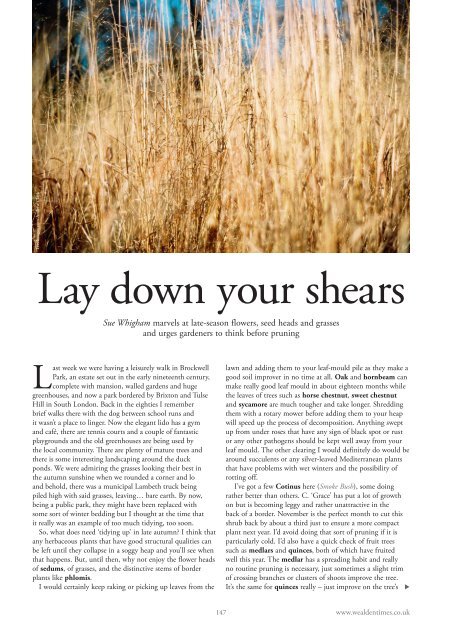Wealden Times | WT165 | November 2015 | Gift supplement inside
Wealden Times - The lifestyle magazine for the Weald
Wealden Times - The lifestyle magazine for the Weald
Create successful ePaper yourself
Turn your PDF publications into a flip-book with our unique Google optimized e-Paper software.
FreeImages.com/Andrew Clark<br />
Lay down your shears<br />
Sue Whigham marvels at late-season flowers, seed heads and grasses<br />
and urges gardeners to think before pruning<br />
Last week we were having a leisurely walk in Brockwell<br />
Park, an estate set out in the early nineteenth century,<br />
complete with mansion, walled gardens and huge<br />
greenhouses, and now a park bordered by Brixton and Tulse<br />
Hill in South London. Back in the eighties I remember<br />
brief walks there with the dog between school runs and<br />
it wasn’t a place to linger. Now the elegant lido has a gym<br />
and café, there are tennis courts and a couple of fantastic<br />
playgrounds and the old greenhouses are being used by<br />
the local community. There are plenty of mature trees and<br />
there is some interesting landscaping around the duck<br />
ponds. We were admiring the grasses looking their best in<br />
the autumn sunshine when we rounded a corner and lo<br />
and behold, there was a municipal Lambeth truck being<br />
piled high with said grasses, leaving… bare earth. By now,<br />
being a public park, they might have been replaced with<br />
some sort of winter bedding but I thought at the time that<br />
it really was an example of too much tidying, too soon.<br />
So, what does need ‘tidying up’ in late autumn? I think that<br />
any herbaceous plants that have good structural qualities can<br />
be left until they collapse in a soggy heap and you’ll see when<br />
that happens. But, until then, why not enjoy the flower heads<br />
of sedums, of grasses, and the distinctive stems of border<br />
plants like phlomis.<br />
I would certainly keep raking or picking up leaves from the<br />
lawn and adding them to your leaf-mould pile as they make a<br />
good soil improver in no time at all. Oak and hornbeam can<br />
make really good leaf mould in about eighteen months while<br />
the leaves of trees such as horse chestnut, sweet chestnut<br />
and sycamore are much tougher and take longer. Shredding<br />
them with a rotary mower before adding them to your heap<br />
will speed up the process of decomposition. Anything swept<br />
up from under roses that have any sign of black spot or rust<br />
or any other pathogens should be kept well away from your<br />
leaf mould. The other clearing I would definitely do would be<br />
around succulents or any silver-leaved Mediterranean plants<br />
that have problems with wet winters and the possibility of<br />
rotting off.<br />
I’ve got a few Cotinus here (Smoke Bush), some doing<br />
rather better than others. C. ‘Grace’ has put a lot of growth<br />
on but is becoming leggy and rather unattractive in the<br />
back of a border. <strong>November</strong> is the perfect month to cut this<br />
shrub back by about a third just to ensure a more compact<br />
plant next year. I’d avoid doing that sort of pruning if it is<br />
particularly cold. I’d also have a quick check of fruit trees<br />
such as medlars and quinces, both of which have fruited<br />
well this year. The medlar has a spreading habit and really<br />
no routine pruning is necessary, just sometimes a slight trim<br />
of crossing branches or clusters of shoots improve the tree.<br />
It’s the same for quinces really – just improve on the tree’s <br />
147 www.wealdentimes.co.uk


















